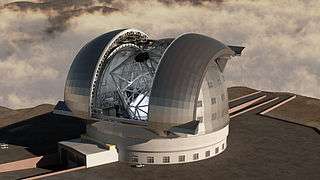Extremely large telescope

| |||||
| Extremely Large Telescopes compared to some existing telescopes (hover with mouse over image) · European Extremely Large Telescope (top left) | |||||
An extremely large telescope (ELT) is an astronomical observatory featuring a telescope with an aperture for its primary mirror from 20 metres up to 100 metres across,[1] when discussing reflecting telescopes of optical wavelengths including ultraviolet (UV), visible, and near infrared wavelengths. Among many planned capabilities, ELTs are planned to increase the chance of finding Earth-like planets around other stars.[2] Telescopes for radio wavelengths can be much bigger physically, such as the 300 metres (330 yards) aperture fixed focus radio telescope of the Arecibo Observatory. Freely steerable radio telescopes with diameters up to 100 metres (110 yards) have been in operation since the 1970s.
These telescopes have a number of features in common, in particular the use of a segmented primary mirror (similar to the existing Keck telescopes), and the use of high-order adaptive optics systems.[3][4] See also the List of largest optical reflecting telescopes for other large finished telescopes.
Although ELT designs are large, they can have smaller apertures than the aperture synthesis on many large optical interferometers. However, they may collect much more light, along with other advantages.
ELTs
The top three ELTs that are being funded, with two smaller but completed large telescopes for comparison (background yellow). In the early 2000s, all three targeted completion in 2018, although this slipped to 2022 for the TMT[5] and 2024 for the E-ELT.[6]
| Image | Name | Aperture (m) | Area (m²) | Primary mirror | Altitude (m) | First light |
Notes | Refs |
|---|---|---|---|---|---|---|---|---|
 |
European Extremely Large Telescope (E-ELT) |
39.3 | 978 | 798 × 1.45 m hexagonal (f/1) |
3060 | 2024 | Under construction: Cerro Armazones Obs., Chile | [6][7][8] |
 |
Thirty Meter Telescope (TMT) |
30 | 655 | 492 × 1.45 m hexagonal (f/1) |
4050 | 2022? | On hold: Mauna Kea Obs., Hawaii | [3][5] |
 |
Giant Magellan Telescope (GMT) |
24.5 | 368 | 7 × 8.4 m circular (f/0.71) |
2516 | 2021 | Under construction: Las Campanas Obs., Chile; 4 mirrors cast (4/7 M1) |
[4][9] |
 |
Large Binocular Telescope (LBT) |
11.8 equiv area 22.8 equiv detail limit |
111 | 2 × 8.4 m circular |
3221 | 2008 | largest non-segmented mirrors; Located on Mount Graham in Arizona |
[10] |
 |
Gran Telescopio Canarias (GTC) |
10.4 | 74 | 36 × 1.9 m hexagonal |
2275 | 2008 | Largest single mirror. Located on Roque de los Muchachos Obs. in the Canary Islands |
[11] |
| Note: Aperture of LBT: the baseline is obtained via aperture synthesis | ||||||||
The Keck Observatory (2 x 10 m) and the Very Large Telescope, of the European Southern Observatory on Cerro Paranal in the Atacama Desert of northern Chile, is also of note, with 4 × 8.2 m and 4 × 1.8 m, all on separate mounts but in one building for interferometry.
Budget
Possible budget figures, which are estimates and can vary over time.
| Name | Cost (est USD) |
Alternate |
|---|---|---|
| European Extremely Large Telescope (E-ELT) | $1400 million | €1055 million (Euros) |
| Thirty Meter Telescope (TMT) | $1200 million | |
| Giant Magellan Telescope (GMT) | $700 million | |
| Large Binocular Telescope (LBT) | $120 million | |
| Gran Telescopio Canarias (GTC) | $172 million | €130 million (Euros) |
Projects
There were several telescopes in various stages in the 1990s and early 2000s, and some developed into construction projects.
- Funded construction
- Projects
Some of these projects have been cancelled, or merged into ongoing ELTs.
- GSMT: Giant Segmented Mirror Telescope, merged into TMT
- OWL: Overwhelmingly Large Telescope;passed over in favor of E-ELT
- VLOT: Very Large Optical Telescope, merged into TMT
- LAT: Large Atacama Telescope
- EURO50: European 50-metre Telescope;merged into the E-ELT.
- LPT: Large Petal Telescope
- JELT: Japanese ELT Project. Japan joined the TMT project in 2008.
- CELT: California Extremely Large Telescope; CELT became/merged into TMT project.
- Swedish Extremely Large Telescope Project.[12]
- MAXAT[12]
See also
- Exoplanet
- Gran Telescopio Canarias
- List of largest optical reflecting telescopes
- Overwhelmingly Large Telescope
- Very Large Telescope
References
- ↑ As A Skeleton Science Case For Extremely Large (20m–100m) Ground-based Telescopes (ELTs) and first section of ELT Roadmap, PDF
- ↑ Jha, Alok (5 August 2006). "Extremely Large Telescope could reveal secrets of life, the universe and everything". The Guardian.
- 1 2 "Thirty Meter Telescope Construction Proposal" (PDF). TMT Observatory Corporation. 2007-09-12: 29. Retrieved 2009-07-24.
- 1 2 "Chapter 6: Optics" (PDF). GMT Conceptual Design Report. GMT Consortium. pp. 6–3. Retrieved 2008-04-02.
- 1 2 Thirty Meter Telescope timeline page, TMT Observatory Project, retrieved 2010-10-12
- 1 2 http://www.eso.org/ eso1419 — Organisation Release, Groundbreaking for the E-ELT, 19 June 2014
- ↑ Govert Schilling - Europe Downscales Monster Telescope to Save Money ( 14 June 2011) - Science Insider
- ↑ http://www.eso.org/public/astronomy/teles-instr/e-elt_num.html
- ↑ http://sen.com, Elizabeth Howell, Giant telescope gets $20m funding boost as design takes shape, 29 December 2014
- ↑ "Large Binocular Telescope Achieves First Binocular Light" (Press release). Large Binocular Telescope Corporation. 2008-02-28.
- ↑ "Giant Canary Islands telescope captures first light". CBCnews. CBC. 16 July 2007. Retrieved 24 July 2013.
- 1 2 ELT
External links
- Australian National Workshop on Extremely Large Telescopes (ELTs)
- The OPTICON ELT Working Group a Europe-wide research project
- The science case for Extremely Large Telescopes (ELTs) from the Royal Observatory, Edinburgh


